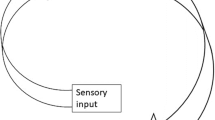Abstract
For certain environments, the Darwinian model allows unique prediction of a function that any surviving system adapted to such an environment has to perform. This is the case for those environments that determine a “survival functional” of position in space-time of known shape. Purely temporal survival functionals can be distinguished from spatial and mixed ones. In each case, there exists an optimum path in combined physical and (reduced) metabolic space. Dependent on the admissible error, approximate solutions of different complexity are sufficient. All solutions possess an afferent, a central, and an efferent part. Within this general frame, specific, “probably simplest”, solutions are proposed for adaptive chemotaxis, insect locomotion, lower vertebrates locomotion, higher vertebrates locomotion, chronobiological systems, and immune systems, respectively—or rather, for the underlying functionals.
Similar content being viewed by others
Literature
Butterfield, H. 1957,The Origins of Modern Science, London.
Burnet, F. M. 1959.The Clonal Selection Theory of Acquired Immunity. Nashville: Vanderbilt University Press.
Bremermann, H. 1974. “Complexity of Automata, Brains, and Behavior.”Springer Lecture Notes in Biomathematics,4, 304–331.
Conrd, M. 1977. “Adaptability of Biological Macromolecules.” Lecture held at the Pfaffelhuber Memorial Symposium, TübingenSpringer Lecture Notes in Biomathematics (in press).
Darwin, C. 1859.The Origin of Species by Means of Natural Selection, or the Preservation of Favoured Races in the Struggle for Life. London: Murray.
Hoffmann, G. W. 1975. “A Theory of Regulation and Self-Nonself Discrimination in an Immune Network.”Eur. J. Immunol.,5, 638–647.
Jerne, N. K. 1955. “The Natural Selection of Antibody Formation.”Proc. Natn. Acad. Sci.,41, 849–857.
— 1974. “Towards a Network Theory of the Immune System.”Ann. Immunol. Inst. Pasteur,125C, 373–385.
Kant, I. 1796. “Epilog.” InÜber das Organ der Seele (On the Organ of the Soul). An Anatomy of the Brain by S. T. Sömmering, Königsberg.
Landahl, H. D. 1947. “An Approach to a Neurobiological Interpretation of Motivational Interactions.”Bull. Math. Biophys.,9, 149–157.
Lorenz, K. 1935. “Der Kumpan in der Umwelt des Vogels.”J f. Ornithol.,83, 137–215; 289–413.
— 1973.Behind the Mirror. London: Methuen 1977 (Transl.).
Rapoport, A., 1947. “Mathematical Theory of Motivation Interaction of Two Individuals.”Bull. Math. Biophys.,9, 17–27.
Rashevsky, N., 1947. “A Problem in Mathematical Biophysics of Interaction of Two or More Individuals Which May Be of Interest in Mathematical Sociology.”Bull. Math. Biophys.,9, 9–15.
— 1961.Mathematical Principles in Biology and Their Applications. Springfield, Ill.: Thomas.
Richter, P. H. 1975.Eur. J. Immunol.,5, 350.
Rosen, R., 1976. “On Rate-sensitive Chemoreceptor Systems and the Origin of the Immune System”.J. Theor. Biol.,62, 429–445.
Rosen, R. 1977.Fundamentals of Measurement and Representation of Natural Systems. (Monograph in press.)
— 1972. “Design for Chemical Growth under Different Environmental Constraints.”Prog. Theor. Biol.,2, 167–211.
— 1974a. “Adequate Locomotion Strategies for an Abstract Organism in an Abstract Environment: A Relational Approach to Brain Function.”Springer Lecture Notes in Biomathematics,4, 342–369.
— 1974b. “An Autonomously Growing Chemical Automaton.”Third Colloq. Automata Theory, Biological, Chemical Systems (J. Riguet, org.), Faculté Necker, Paris, May 1974.
Rosen, R. 1975. “Dynamical Network Model of an Immune System.”Fifth International Biophysics Congress, Copenhagen 1975.
— 1976a. “Prescriptive Relational Biology and Bacterial Chemotaxis.”J. Theor. Biol.,62, 141–157.
— 1976b. “Deductive Theory of Chronobiological Systems.”Proc. IEEE Int. Conf. on Cybernetics and Society, pp. 321–323. New York: The Institute of Electrical and Electronics Engineers, Inc.
— 1977. “Path-optimization on the Basis of Direction Optimization.”Progress Cyb. Systems Research,3, Hemisphere Publ. Corp., Washington, D.C. (in press).
Rosen, R. and R. A. Lutz. 1978. “Dynamical Network Model of an Immune system.” (In preparation).
Shulman, M. J. 1974. “Model for Wandering Restriction Enzymes.”Nature, Lond.,252, 76–77.
Simon, H.A. 1957.Models of Man, New York: Wiley.
Von Holst, E. and H. Mittelstaedt. 1950. “The Reafference Principle.” (In German.)Naturwissenschaften,37, 464–479.
Von Neumann, J. and O. Morgenstern. 1947.Theory of Games and Economic Behavior. Princeton: Princeton University Press.
Author information
Authors and Affiliations
Rights and permissions
About this article
Cite this article
Rössler, O.E. Deductive biology—Some cautious steps. Bltn Mathcal Biology 40, 45–58 (1978). https://doi.org/10.1007/BF02463129
Issue Date:
DOI: https://doi.org/10.1007/BF02463129




